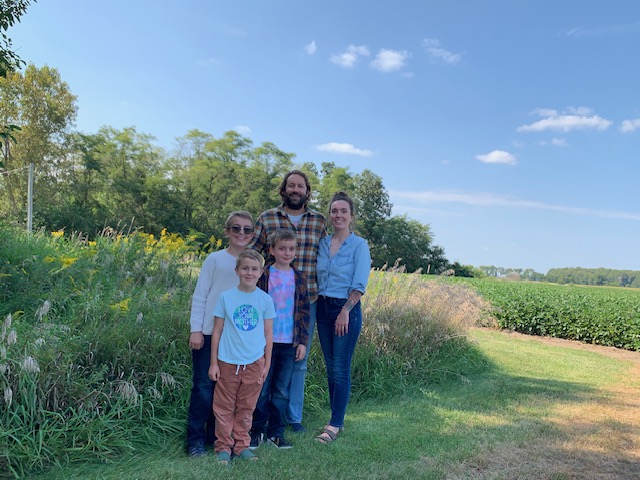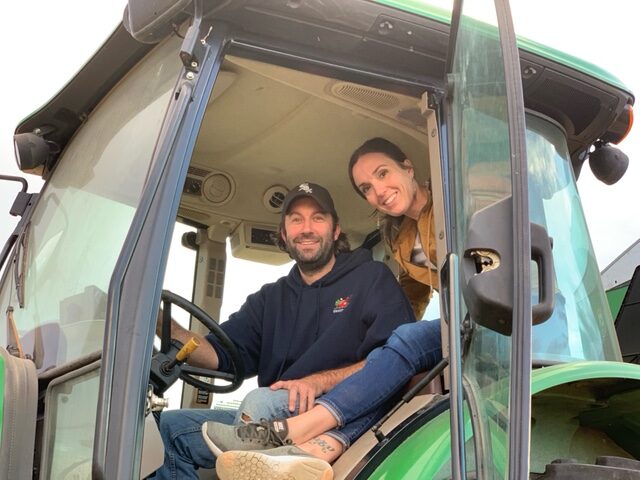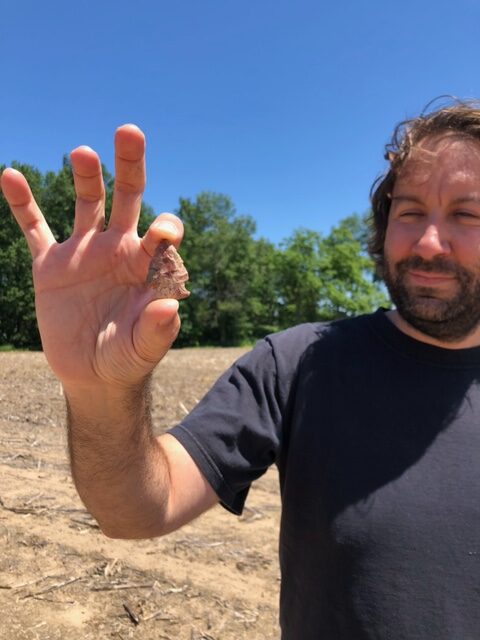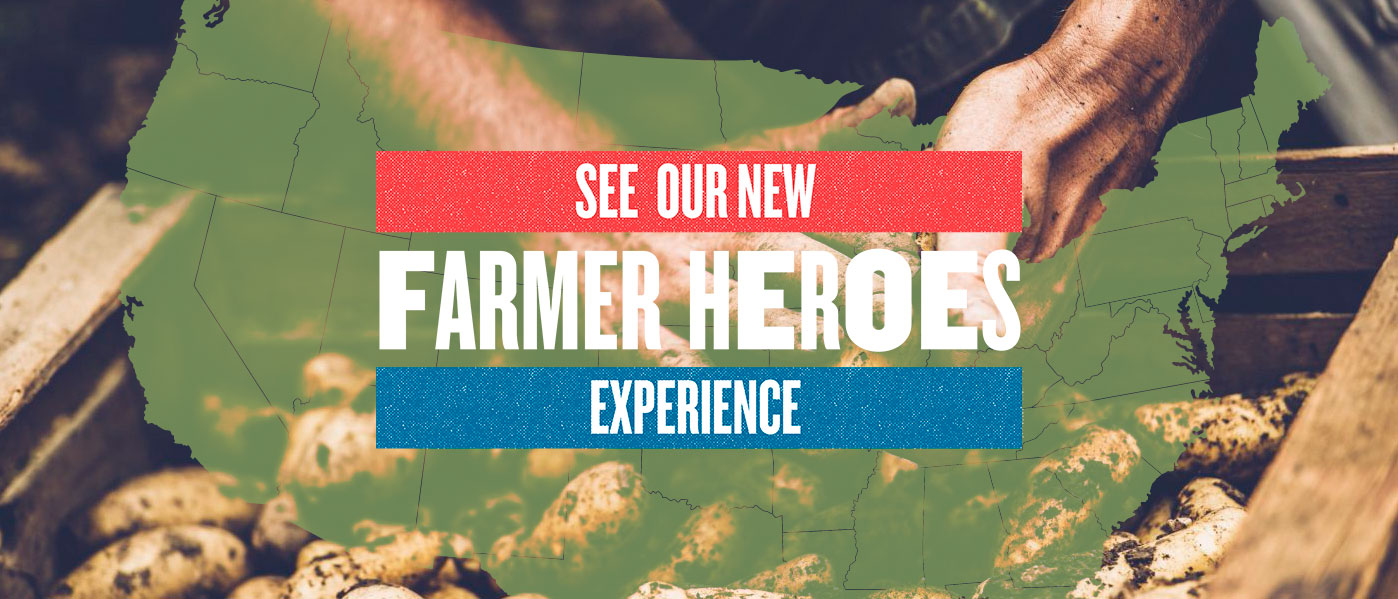Andrew Westfall knows that his path to becoming an Indiana farmer is much like many other farmers in a state where 80% of the land is devoted to agriculture. He grew up on his family’s farm in White County, Indiana, and spent his childhood helping out on the farm, taking care of livestock and chickens and surrounded by crops. He studied agriculture in college and worked in the agricultural support field. Then, five years ago, he and his wife Elizabeth decided it was time to return to the family farm and raise their young children on the land that has been in their family for three generations.
When they arrived, Andrew took over the bulk of the work on Westfall Farms, which focuses on producing corn and soybeans. Sixty percent of the crops grown in Indiana are corn and soy, and while some of that corn and soy ends up on tables, much of it is grown for animal feed. Westfall farms is no exception.
The farm is 400 acres, which, for corn and soy production, is on the small side. Other farms in the area are generally 2,000-3,000 acres. Westfall Farms’ production is a scaled down version of those other farms. “Whereas they have a 24-row corn planter, we do our planting with an eight-row corn planter. So basically everything we’re doing is just smaller—the equipment’s smaller and the operating costs are smaller,” Andrew explains. “That’s kind of what our area of the country is set up for, so that’s what we continue to do. A lot of that decision, aside from the system that we’re participating in and the ease of access to markets, a lot of it comes down to time.”
Over the years, Westfall Farms has expanded a bit, but it has always stayed within a one-mile radius. While they have recently considered expanding, it doesn’t make sense right now for Andrew and his family. On top of the cost of buying more land, the cost of updating equipment is prohibitive, and it would require larger operating loans. Plus, Andrew works a full-time job in addition to running the farm. This is very common: 98% of farmers have some off-farm income. The numbers tell you why. Median farm income earned by farm households (not counting off-farm income) is estimated to have decreased in 2022 to -$849 from $210 in 2021 and is forecast to decline further to -$880 in 2023.
For Andrew and his family, working off-farm full-time and keeping the farm small so he can farm part-time just makes sense. Elizabeth is able to stay home with their three kids, and for Andrew, having a second job that is only a few busy seasons, rather than 12 months out of the year, works. As it is, he’s able to do the entire harvest in one week. Through his job managing part of the research farm for Purdue University’s Diagnostic Training Center, he is able to provide health insurance for his whole family. Access to healthcare coverage is an issue that most farmers grapple with. If the Westfalls ever decide to expand the farm so that he can farm full-time, Andrew’s approach is to be patient and thoughtful with the process. Keeping the farm within one square mile saves time and money.
“These acres of land are kind of set up like a Monopoly board and some of these folks have been playing Monopoly for decades and putting their hotels and stuff on these spaces.”
And yet, even if they wanted to expand, the Westfalls would be contending with a challenging situation. “These acres of land are kind of set up like a Monopoly board and some of these folks have been playing Monopoly for decades and putting their hotels and stuff on these spaces.” Andrew is conscious of how privileged he is to have inherited this land. “Land access would be my biggest concern if I was a beginning farmer,” he says. “Not only are you having to purchase land, you’ve got to find a way to justify a tractor that’s a couple hundred thousand dollars and so capital and land would be [the] number one [challenge] for younger farmers unless they’re in a situation where they’re born into it.”
Another hurdle that first generation farmers face is that the entire local farming system is set up for corn and soy. If you’re hoping to do something different, you might be swimming upstream. In northwest Indiana, nearly every small town has a grain elevator and grain market (either run as a farm coop or privately owned). There’s a grain elevator three miles down the road where Andrew sells their corn, and the soybeans travel just a little further. The market for corn and soy is well supported by this infrastructure and agronomic service companies. “There’s plenty of support and there’s no concern about not having a market for your product that I’ve experienced,” he says.
Andrew notes the irony that most of White County is functionally a food desert even while being surrounded by some of the most fertile land in the country. (The USDA defines a food desert as an “area in which a substantial number or share of residents is far from a supermarket or large grocery store.”) He points out that, due to the lack of infrastructure and market, “within seven to eight miles there’s three different grain elevators where I could take hundreds of acres of corn that I grew, but if I grew an acre of tomatoes, that’s a major risk.” Andrew knows that farms with more diverse crops have struggled in northwest Indiana because of the lack of markets for non-commodities.
It’s a challenge that several organizations are working on, and there’s more to do. Andrew worked with Purdue Extension for six years, where he connected with Purdue’s Diversified Farming and Food Systems team. He has seen firsthand how much of a risk it can be to start a farm, and Purdue has stepped up in recent years to expand their support for beginning and diversified farms, though at the moment that is focused mostly on urban areas. However, the work to expand support for diverse vegetable markets to rural areas in Indiana continues.
Andrew also recognizes that these land access struggles coupled with a lack of markets also impacts racial justice in the Indiana farming community. “In our farm situation, I’m taking the steps to acknowledge that I am coming from a point of privilege that I’m farming land that I was just born into, in a part of the world where it’s not necessarily up for grabs. Farms started being purchased in this area a few hundred years ago and it’s not that they have opened it back up to other folks to work their way into the system.” He has also found several arrowheads on his land, which has come with some sadness, knowing that most of the Native tribes in Indiana were forced from their land.
Even though he isn’t a beginning or first-generation farmer, Andrew is a young farmer, and as he looks to the future, he plans to make some changes on the farm, slowly and thoughtfully. Farming with family can be complicated; at this point he does most of the labor on the farm, while his dad works closely with him as an advisor. His aunt and uncle also live on the farm and participate where they can. Andrew’s approach to these family dynamics is to focus on good communication and to allow everybody “some grace and time to process everything.” His intention is to introduce transition on the farm at a pace that everyone is comfortable with.
One thing that Andrew is interested in is introducing new technologies on the farm. He has bumped up against the digital divide that limits how much farmers in rural areas can access online technologies due to inadequate internet service. However, he has seen this change in recent years and feels confident that this will continue to improve with time.
He’s also interested in doing more regenerative farming in the future. In the early 90s, his dad was one of the first farmers in the area to start practicing no-till farming, a sustainable farming practice that really saved their topsoil. “I’d hate to think about what I would be working with had it been heavily tilled for the last 100 or 200 years.” Andrew plans to continue to do no-till, first because it’s more efficient and also “because our soil is our greatest resource, so to leave it as intact as possible and let that ecosystem thrive like it’s supposed to is always a good thing.”
Andrew doesn’t just want to sustain the soil, but feed and build it up. One way he plans to do that is with cover cropping. However, cover cropping means investing in new machinery and adding time to his farming schedule. (Here’s how Farm Aid is advocating for policies that support farmers who would like to transition to regenerative farming.) As with the rest of the farm’s transitions, his plan is to make the transition to regenerative a little at a time, with plenty of thoughtfulness, patience and communication.






